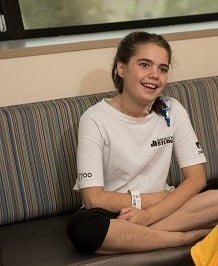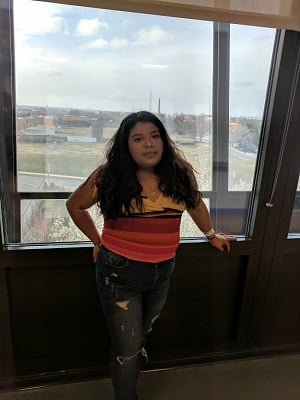
Kaylee and Roxi's Story

The two young women chatter away as kids often do, talking about music, life and their amazing new kidneys. The chances that they would be in this hospital room, sharing the same experiences and finishing each other’s sentences, are infinitesimally small.
Kaylee Townsley, a seventh-grader, is 12 and is “more than obsessed” with One Direction. Roxi Vasquez, a high school senior, is 18 and dismisses the boy band with a silent wave of the hand. They live in different towns and attend different schools.
But one day, their dialysis schedules changed. Roxi was on her way to the cafeteria at Children’s National Health System and spotted Kaylee. It seemed every time Roxi went to the café, Kaylee was there, too. “We just started talking,” Roxi recalls.
 Turns out these very different kids were very much alike: Both had end-stage kidney disease. None of their combined four kidneys retained complete function. Both awaited a life-saving transplant.
Turns out these very different kids were very much alike: Both had end-stage kidney disease. None of their combined four kidneys retained complete function. Both awaited a life-saving transplant.
Kidneys are small organs shaped like kidney beans. Despite their small size, kidneys play an outsized role in the body by filtering waste products; excreting potassium and excess water; maintaining an essential balance of salts, minerals and electrolytes; and producing certain hormones.
“Dialysis can take on the kidneys’ essential roles, providing a life-saving bridge until such time the patient is ready for a transplant,” says Kirtida Mistry, M.D., a Children’s National nephrologist.
With dialysis on the same schedule, Roxi and Kaylee drew even closer. Then came the day they learned they would receive a transplant. One started to cry, which led to the other one crying.
“Kaylee was starting to lose hope,” says grandmother Dee Buzgierski. “I told her to keep the faith: Things happen when you least expect it. Kaylee was so happy; she dropped to her knees, crying.”
Roxi has no sisters and her male cousins are older. Kaylee has two biological sisters and a brother. Both received a transplant on the same day. “Now, we’re sisters,” Kaylee explains. “I have three sisters.”
 Just a door separated the pair as they recuperated, post-surgery. Kaylee and Roxi became each other’s source of strength and inspiration, confirming which food and drink was OK to eat, marveling at how much fluid they could now drink, divulging which drug tasted like bananas gone brown, and coaxing each other to get out of bed and move. When one was scheduled for a procedure, the other asked how it would go and whether it would hurt, knowing her “sister” would provide sage advice in person or via text.
Just a door separated the pair as they recuperated, post-surgery. Kaylee and Roxi became each other’s source of strength and inspiration, confirming which food and drink was OK to eat, marveling at how much fluid they could now drink, divulging which drug tasted like bananas gone brown, and coaxing each other to get out of bed and move. When one was scheduled for a procedure, the other asked how it would go and whether it would hurt, knowing her “sister” would provide sage advice in person or via text.
“We were on this floor a few days ago. She was up and walking. She came to my door,” Kaylee says. “I just wanted her to get better. For both of us to get better,” Roxi adds.
Before the transplant, both faced dietary restrictions.
“Because the kidney does so much essential work, when children have reduced kidney function we have to be very careful about what kind of foods and fluids they digest and how much,” Dr. Mistry says. “It’s a delicate balance, because we want to ensure that the fluid intake does not exceed the body’s ability to handle that liquid.”
Reveling in the newfound freedom, Kaylee cracks open a can of soft drink. Roxi’s eyes widen.
“Is it OK to drink that?” Roxi asks.
“Roxi, we can drink anything. We can eat anything: We’ve got our kidneys. Go right ahead,” Kaylee says. “You have to learn. You have your kidney. You can do anything.”
“I know. It’s real,” Roxi nods.




